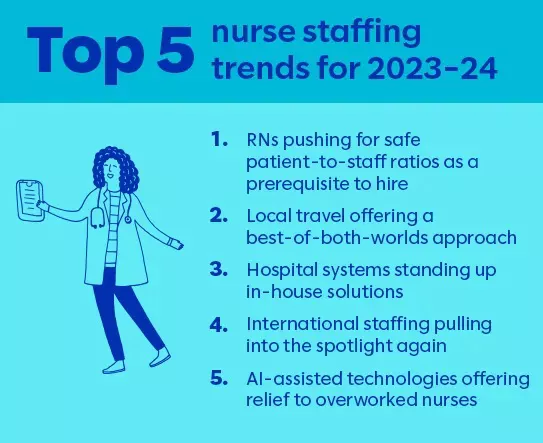Top five nursing staffing trends in 2023–24
 Collaborative solutions for a persisting problem
Collaborative solutions for a persisting problem
The US has been talking about nursing staffing shortages since the 1930s — in fact, throughout the most impactful and trying times in our history, the drumbeat has been consistent: we need more nurses on the frontlines. And as the perfect storm of COVID-19 burnout, increased profitization of the healthcare system, and the baby boomer retirement wave hits, the American Association of Colleges of Nurses predicts the US will continue to experience a nursing staffing crisis until 2030.
Across the country, hospital systems, healthcare staffing agencies, and government organizations are focused on solving the RN shortage problem — a solution that will positively impact clinical outcomes, patient safety measures, and financial viability.
Efforts to meet staffing demand while strengthening the nursing experience are pushing some trends across the industry to the top in Q2 2023. These solutions combine people, processes, and technology to meet the problem where it is while building bridges to innovate the future of healthcare staffing.

1. Nurses are demanding safe working environments and will leave the profession before engaging in high patient-to-staff ratios.
It’s a chicken and egg situation, but hospital systems looking to win the battle for talent need to focus on maintaining safe patient-to-staff ratios while building out more long-term financially stable strategies.
Nursing unions across the US have executed labor actions in Q4 2022 to demonstrate their staunch commitment to safe and healthy working environments. In the US, medical error is the third leading cause of death and has increased since COVID-19 due to staffing shortages, burnout, and shifting prioritization.
Nurses have stated unequivocally that patient harm contributes highly to their burnout — without healthy patient-to-staff ratios, many RNs assert they can’t guarantee the safety of all their patients. Couple that with forced overtime, inflexible schedules, little to no time off, and increasing workplace violence, it’s no wonder RNs are looking for positions outside of hospital systems and sometimes out of the profession altogether.
Creating a future-proof staffing plan starts with a healthy mix of staffing options to keep patient-to-nurse ratios low. Decreasing patient harm risk and increasing support differentiate provider systems as the most attractive employment options for talented nurses.
2. Local travel is emerging as a middle-ground solution.
Travel nursing has experienced a boom in the last few years as RNs left their full-time provider system positions in droves to travel the US for myriad reasons and opportunities, including higher pay, schedule flexibility, to be closer to aging family, to flux into regions that were hurting most during the pandemic, etc.
The dust is settling in 2023, however, and RNs are looking to stay more centralized to their “home” locations. In addition, healthcare systems are prioritizing financial viability in staffing and looking to divest from the agency staffing costs that have ballooned over the last few years, creating the concept of “local travel” as an option for all.
Local travel works similarly to travel nursing, except that RNs stay in closer proximity to where they live. This eliminates many of the extras travel nurses get to incentivize their cross-country moves. While RNs will still make more in local travel than staff positions for the most part, they will make less locally than nationally, and healthcare systems will pay less of a premium.
Because nurses continue to prioritize flexibility in scheduling as a main satisfier, the local travel option offers time off between contracts and flexibility in shifts, units, and provider systems without the risk of uprooting from a home location.
We’re also seeing local per diem (per day staffing) arise as a trend in 2023, leading to our next trend.
3. Provider systems look to stand up in-house staffing agencies to quell the demand.
Many healthcare provider systems are bringing processes in-house to address their staffing needs by standing up mini in-house staffing agencies focusing on building local per diem or “gig” pools they can lean on whenever influxes in capacity occur.
By building direct relationships with part-time and travel RNs in their region, and strategically partnering with other provider systems, in-house solutions can offer more readily available staffing options with locals who are known in their system and can flex in and out easily.
With these in-house solutions come technology underpinning logistical operations solutions:
- Dashboards with predictive analytics capabilities that forecast staffing needs and inform the demand the hospital system can anticipate for the year
- Revenue operations predictive tools to boost budget planning accuracy
- Digital scheduling apps leveraging machine learning and scheduling algorithms
- Platform integrations to streamline operational efficiency, focusing on scheduling, timekeeping, and people management
4. International staffing offers a long-term solution to the US staffing problem and is viable again.
Pre-COVID executive branch policies followed by the pandemic’s international travel shutdowns impacted international staffing, temporarily derailing it as a viable option. Now that both market forces are in remission, international staffing will ramp back up as an RN staffing solution that offers long-term placement (with potential conversion at the end of a contract) options with experienced RNs who intend to move to the US.
International staffing options have three main benefits for hospital systems:
- International travel nurses are usually experienced and are able to quickly step onto floors as leaders.
- International staffing costs are less than US travel nurse staffing.
- Many international RNs will convert to provider systems they invest in, creating a permanent solution to staffing shortages within systems.
For RNs intending to live and work in the US, international staffing opportunities offer a pathway to new career opportunities and widen the pipeline of staffable nurses within the US. Additionally, healthcare staffing organizations offering multiple staffing options and solutions fare better in becoming a staffing agency of choice within the market.
5. Artificial intelligence (AI) breaks down barriers in staffing new RNs, retaining currently employed RNs, and increasing clinical measures.
For a long time, due to budget constraints and prioritizations not experienced in the private sectors, non-profit and academic medical center healthcare centers were technology laggards, falling behind in leveraging automation and AI tools to propel the future of experience, staffing, patient safety, clinical outcomes, etc.
Though there’s still a lot of ground to cover, healthcare is emerging as early tech adopters, specifically regarding machine learning, algorithmic predictive analytics, and AI-assisted processes. For example, 8–16% of nursing activities could be delegated to AI technology, freeing up time for RNs to focus on patient outcomes. Harvard researchers estimate that AI technologies could reduce treatment costs by 50% while improving outcomes by 40%.
A few AI applications within the healthcare industry that are likely to impact staffing in 2023 include:
- Scheduling algorithms that simplify the scheduling administrative process and free internal people resources to focus on other parts of acquisition and staffing
- Predictive analytics to anticipate staffing trends and create more accurate staffing plans
- Direct-patient care assistance, particularly on more administrative information-gathering tasks that can free RNs up to do more direct patient care
- AI-enhanced RN education tools to speed up continuing education, certifications, training, and onboarding
Outside of emerging 2023 trends, the foundational tenants remain — a strong RN-centered experience enabled by people, processes, and technology is the best strategy.
RNs seek flexibility, safe workplaces, career advancement, and opportunities to meaningfully connect with their communities. In the race for nursing talent, organizations that demonstrate agility in how to serve RNs and invest in their experience will pull ahead as employers of choice.
Learn more about today’s healthcare trends from Slalom here.

-1?fmt=webp-alpha&metadata=none)
